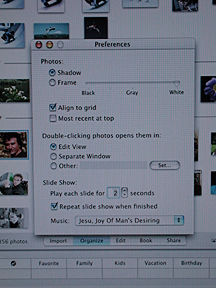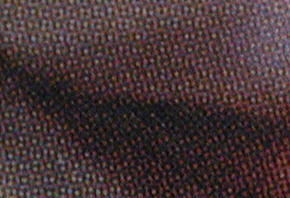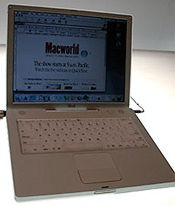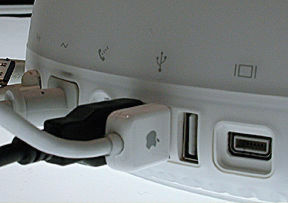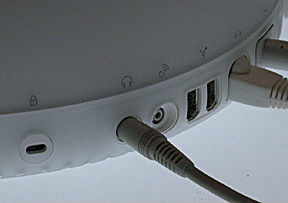| Macworld Expo report | |
MACWORLD EXPO
Jobs: 'It's Time'
By MIKE PASINI
Editor
Imaging Resource Digital Photography Newsletter
It's time to change the posters, too SAN FRANCISCO -- "It's time," Apple's Steve Jobs said today at the Macworld Expo opening keynote address, which preceded the Expo itself by a day. He was talking about Apple's decision to start shipping Macs with OS X as the default operating system but it's time for a lot of other things, too, his keynote illustrated.
C O N T E N T S
Time for an inexpensive but state-of-art digital imaging machine. Time for a simple-to-use but capable digital imaging application. Time to tap into iTools and Apple servers for image sharing. Time, most of all, to take Jobs -- and Apple -- seriously.
Jobs' two-hour presentation included a number of imaging industry luminaries from Adobe's Russell Brown to LucasFilm's George Lucas, spotlighting the growing number of OS X-native applications. Jobs also introduced a new iBook, with a larger screen and a combo drive, as well as the new iMac, sporting a new cataloup design and priced as low as $1,299.
Apple has clearly "thought different" about prices.
After the keynote we were invited to take a closer look at the new hardware and software in a special preview of the Apple booth. We got a deeper look at iPhoto, the free OS X imaging application, as well as some closeups of the new machines.
THE KEYNOTE | Back to Contents
Jobs neatly organized the keynote into five subjects: Updates, OS X, the Digital Hub, the iBook and the iMac.
UPDATES | Back to Contents
Jobs tossed some interesting numbers to the crowd ravenous for good news:
- In the last year, 27 new Apple stores were opened, displaying some 500 software titles
- While some 95 percent of computer users are not Mac users, 40 percent of the CPUs sold at Apple stores were to people who do not own a Mac.
- Visitors at the stores in December alone reached 800,000, ten times the expected number of visitors for Macworld Expo.
- Which may explain how 125,000 iPods have been sold in the product's first 60 days.
Jobs also noted that Apple has partnered with the state of Maine to provide every seventh and eighth grader and their teacher with an iBook -- some 36,000 of them. "One down, 49 [states] to go," Jobs joked, admitting Texas may be "a challenge."
OS X | Back to Contents
After observing that Mac programmers are now writing for Unix and more Unix programmers are writing for the Mac as a result of OS X, Jobs said Apple has spent the last three months helping developers ship OS X titles. As a result, some 2,000 applications are now available for the platform, a 40 percent increase in the last 90 days.
Adobe's Shantuu Narayen then discussed Adobe's vision of "network publishing" in which content is easily morphed into video, Web, wireless and print output. He listed the company's OS X-native products: Acrobat Reader, Illustrator 10, After Effects 5.5 before yielding to Russell Brown to demonstrate the power of Adobe's integrated applications. InDesign maintained Photoshop transparency, reading native Photoshop and Illustrator files. Brown also gave a quick demo of Photoshop on OS X.
"It's real, it's almost here," Brown laughed as he pulled up a Lord of the Rings poster and showed how quickly and easily a number of effects could be achieved -- including a spell check. Much of what he did, intriguingly, was via AppleScripts. Apparently Photoshop on X is a lot more AppleScript savvy than the product has traditionally been.
"I think we're the poster child of applications for OS X," Narayen chided Jobs, who had awarded that honor Microsoft for Office.
Todd Brady, Palm CEO, showed how Palm has made their OS X sofware "as simple as we can" make it. Vcards only have to be dragged and dropped to or from the desktop to show up in or be exported from Palm applications. A beta is available for download at the Palm site, he said.
Mike Evangelist, Apple marketing manager, demonstrated real-time transitions, titling and color correction in the new release of Final Cut Pro 3. The G4 with its velocity engine, OS X and QuickTime were all leveraged to provide these breakthough real-time effects. And, with a PowerBook, video editors can now have a complete and powerful portable professional video editing system.
Probably the most amusing presentation was by Wolfram Research co-founder Theodore Gray who demonstrated Mathematica on OS X. Opening the application with an elegantly typeset equation, he marveled, "It's like everything looks better in OS X." Claiming "the homework of the world doesn't stand a chance," he showed how open-ended, complex math problems were no problem for OS X because if you need RAM, the operating system provides it. That's important in math, he said, because sometimes calculations have to run for days -- "without stopping."
Aspyr's Mike Rogers gave a sneak preview of his companies new games for OS X, including a Harry Potter adventure game in which you are Harry and even get to play Quiddich. Aspyr released 10 new titles last year for the Mac and Rogers was particularly excited about Star Wars Galactica for this year.
Finally, Dan Gregoire, LucasFilm animatics supervisor, showed how Maya and After Effects is making it easier for boss George to fiddle with his new work-in-progress (whose opening sequence has already enjoyed some 20 revisions). A short video message from Lucas introduced the demo.
That's when Jobs stepped back into the spotlight to announce it's time for all new Macs to ship with OS X as the default operating system. System 9.2 will still be installed and can be selected as the default as simply as picking a new startup disk. But OS X will be the first thing you see.
THE DIGITAL HUB | Back to Contents
At last year's keynote, Jobs introduced the concept of the personal computer as a hub for our increasingly digital lifestyle. We're surrounded by "amazing devices," he said, of two types.
The first is enhanced by the digital hub, like camcorders whose long sequences profit from tight editing and DVD players (now in one-third of all homes) that can display movies and slideshows produced on a digital hub. But the second type actually require a digital hub. And among those devices he pointed out MP3 players like the iPod and digicams.
In the year since the concept was introduced, Apple released iMovie2, iTunes and iTunes2 (eight million copies of which have been downloaded), iDVD and iDVD2 (some one million blank DVDs have been sold in that period). All now at version 2, he noted, but one application has been neglected. "What about digital cameras?" he asked.
CHAIN OF PAIN | Back to Contents
"Digital cameras are exploding, revolutionizing the way we take pictures," Jobs noted. Last year, six million digicams were sold in the U.S. alone. Excluding one-time cameras, 30 percent of all cameras sold were digital, he said.
But using a digicam isn't easy. Jobs described a "chain of pain" that included importing your images from the camera to your computer, editing them and printing them. Each step of which he described as "a nightmare" requiring multiple applications.
So Apple developed iPhoto, their first digital photography application. Connect a digitam to your Mac running OS X and iPhoto launches automatically, importing your images to your hard disk where they are automatically cataloged. You can assign keywords to them, group them in albums (much like iTunes) and edit them. And if you don't like the size of the thumbnails you're looking at, you can easily scale them with a slider.
Editing lets you rotate your images. And you can crop them either freehand or constraining them to specific aspect ratios (like what you need for a 4x6 print) and the cropping tool simply ghosts the area to be removed making it very easy to see what you're doing. No more marching ants! Red-eye elimination is just a matter of drawing a marquee around the eyes and clicking the red-eye tool.
And if you prefer to use your own image editing program, you can tell iPhoto to do so in its Preferences panel. "Unfortunately," Jobs said as he demonstrated that, "I don't have Photoshop running on OS X now."
iPhoto Preferences Jobs marveled at the output of today's inkjet printers but complained you could spend years figuring out all the settings to optimize output -- and they're different for every printer. All you have to do in iPhoto, he said, is pick the printer, pick the type of paper, set the margin (or border) and press Print in a special print panel to "get dynamite prints."
To do that a lot goes on behind the scenes via ColorSync, including reading any ICC profile associated with your image by either your camera or subsequently by Image Capture.
But import, edit and print is old thinking. Apple wants you to "save, organize and share" your images.
Share is the new one. And iPhoto taps into iTools for some interesting new possibilities.
You can easily create a slide show with cross fades courtesy of Open GL and easily add music. And they can be exported as QuickTime movies.
But to share, you have only to click on a Publish button to connect to Apple's servers and have OS X upload your images and create a Web page of them (including a Web slide show option).
You can also have them printed by Kodak in sizes up to 20x30 (for $19.99). A simple panel showing the images, quantity ordered, prices (with live update) and a Buy Now button with shipping options makes it simple to order. No "proceed to checkout" or price hiding.
Cover Inside page Binding Halftone close-up (it's ink) But the new sharing option Jobs introduced was the big news. Using a built-in page layout program that provides for both multiple images and text captions on a page in half a dozen different styles, you can automatically create a linen-covered, hard-bound book for $29.99 for the first 10 pages and $3 for each additional page. The books are printed one-sided on glossy paper in ink not toner.
A larger iBook Like iTunes, iPhoto is a free 14-MB download from http://www.apple.com/iphoto to owners of OS X.
NEW HARDWARE | Back to Contents
The iBook gets a new sibling, this one sporting a 14-inch screen, six-hour battery life and a combo drive providing CD reading and writing and DVD reading for $1,799. But the original iBook got a new price tag, starting at $1,199 with a CD reader and $1,499 for a combo drive.
Welcome as that was (particularly in Maine, presumably), the big news was the new iMac, all of which include G4 processors.
The new iMac Somewhat resembling those hi-intensity lamps of the 1970s, the 22-lb., 10.5-inch diameter base is a hemisphere with connectors in the back and a removable baseplate for adding RAM or an Airport card. The head (amusingly animated in commercials) is a 1024x768, 15-inch flat panel LCD monitor that can be raised, lowered, angled or swiveled with the touch of a finger. It comes with a white keyboard and mouse to match the white base and monitor.
Connections available include two FireWire, five USB, 10/100BASE-T Ethernet, 56K V.90 modem. An internal 18-watt amp and Apple Pro speakers are available on some models.
The high-end 800-MHz model with a DVD-R/CD-RW SuperDrive, 256-MB SDRAM, 60-GB Ultra ATA drive and speakers for $1,799 will be available by the end of the month. But Jobs said it's already too late to make the first order. That honor went to Genentech, the biotech firm, which has already ordered 1,000 units.
Rear ports, admiral By the end of February, a $1,499 700-MHz model with a combo drive, 40-GB drive and speakers will ship and by the end of March, a $1,299 700-MHz model with 128-MB SDRAM and a CD-RW drive will fill out the lineup.
INNOVATE | Back to Contents
While competitors have been retrenching and laying off thousands, Jobs said, Apple has been innovating. He listed the accomplishments of the last year and promised the company isn't going to stop. He believes, he said, they see the future. The Digital Hub is the key to the next Golden Age of computing.
And if that sounds hyperbolic, he isn't the only one who thinks so, he concluded, holding up the Jan. 14 issue of Time magazine up with the new iMac on the cover and the big question, "But will millions of PC users get it?"
Whether they do or not, one thing was clear. Apple has delivered a total imaging solution from hardware through software both locally and on the Internet tailored to avoid the pitfalls that most discourage new enthusiasts. They are the only company positioned to take on that responsibility and they continue to make it not just possible but easy to graduate from consumers of our media culture to authors of it.
As Francis Ford Coppola said in a video segment praising the iMac, you wish you had a few million of these. To give to kids. To create. After all, it's time.

